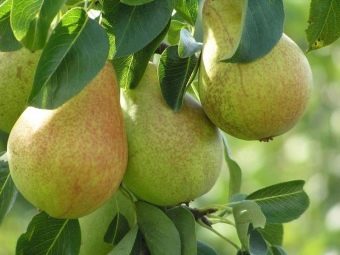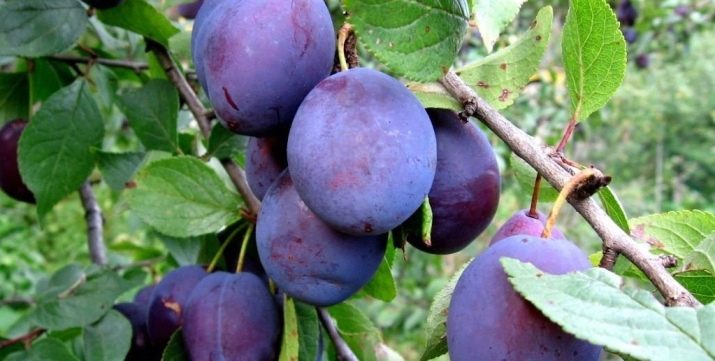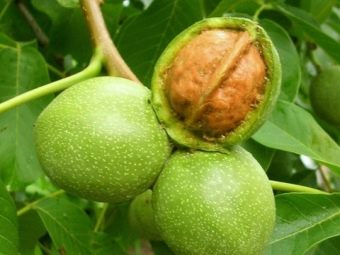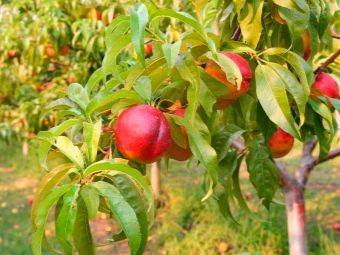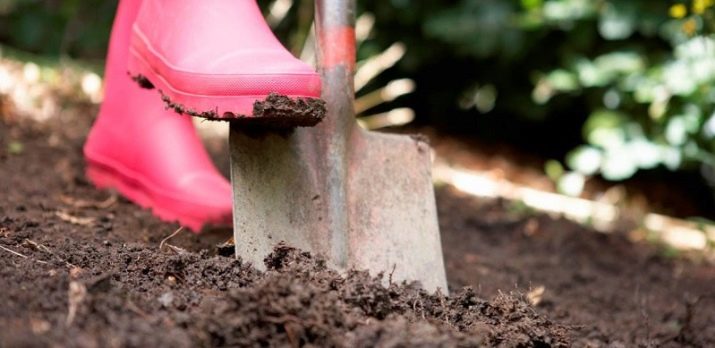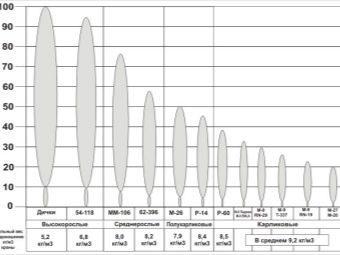Fruit trees for the garden: features of choice, planting and care

Garden - both decorative and fruit for summer residents with many years of experience and only beginner amateur gardeners is of great importance. Therefore, its creation, arrangement and subsequent maintenance of crops should be approached with the utmost seriousness, so that the regular harvests of environmentally-friendly and tasty berries and fruits grown in their own land become the results of hard work.
The best trees for the garden
Despite the fact that more and more summer residents and owners of private houses use their land for planting crops that have a purely decorative function, fruit trees can be found in almost every garden. Due to the peculiarities of fruit crops, it is not only aesthetic to fulfill, but also to delight with large yields of tasty fruits. And after planting one fruit plant, as a rule, it is already quite difficult to stop, therefore the plot of land in a very short time takes on the appearance of a real and full-fledged garden with various fruit plantations. But in this matter there are a number of nuances, any gardener should strictly adhere to them in order to create a beautiful and productive garden.
First of all, it is important to correctly select the planting material for your site, since the development and future fruiting of the crop will directly depend on the choice made. With a similar question It is necessary to contact a specialized nursery, which is guaranteed to pick up a good and healthy planting material.
Setting the task of planting fruit trees, it is also necessary to determine the names and types of crops that should be present on the site.
Of course, any gardener or summer resident wants to see different types of plants in his garden, and it is desirable that there be as many of them as possible. But in this matter you have to limit yourself Since the selection of the best crops in one or another case should be carried out taking into account a number of important factors, such as:
- climatic conditions in the region;
- land area;
- the specifics of the terrain of the area;
- type of soil;
- personal abilities and abilities gardener.
Preference should be given to crops that are zoned for this region, exotic plants can also be planted on their own plot, but they will require more thorough care, so it is important to objectively evaluate your strengths and capabilities. Special attention should be paid to the level of groundwater, as even a strong young sapling, successfully developing in the garden for several years, may die if its root system reaches moisture.
For the Central and Northern regions, preference should be given to apple, apricot, plum, sweet cherry or mulberry trees. In the southern regions, peaches, nectarines, and quinces grow well and bear fruit; in some areas, success can be achieved during persimmon cultivation. As for crops that grow beautifully throughout Russia, you can dwell on some popular plants.
Apple tree
This culture is divided into several species, classification occurs on the basis of the period of fruiting. Apple trees can be divided into winter, autumn and summer. Among the popular varieties that bear fruit in the summer are “Grushovka”, “Melba”, “Papirovka”; among the autumn crops, “Macintosh” and “Antonovka” can be distinguished. For winter apple trees include "Richard", "Golden" and others.
Pear
In this case, cultures are also divided into species based on the ripening season of fruits. For early varieties include "thin wall" or "Carmen", autumn species - "Red-sided" or "Michurinskaya beauty", among the later varieties that have good keeping quality, it is worth noting "Saratovka" or "Kondratyevka."
Cherry
Most often acquire varieties, the berries which reach ripeness by June. These crops include cherry "Baby", "Chocolate", "Wonderful Cherry".Mid-season plants should be considered "Night" or the same "Minx". Crops that allow harvesting closer to the end of July are Turgenevka, Molodezhnaya and others.
Apricot
Suitable for any region are varieties "Alesha" and "Leskore". The late cultivars include the siren and the red partisans.
Plum
The most suitable crops for dacha consider the varieties "Valor", "Hungarian Donetsk", "Ode".
The best option for many household plots are columnar cultures, which make it possible to save garden space, but the ability to bear fruit does not suffer in any way. In the mini-gardens you can find dwarf apple trees, plums, apricots and cherry plums.
Choosing a place for cultivation and site preparation
Since any area of the site is not limitless, the total number of shrubs and trees that can be located on it has its own quantitative framework. Therefore, the question of selecting the location of fruit trees in the garden will be of high priority during the planning of the future planting. Some gardeners make the mistake of locating crops very close to each other in the hope of saving space on the site. As a result, as trees grow, their yield drops sharply, and, moreover, crop formation occurs with errors that are fraught with frequent diseases. Planned planting is necessary taking into account the fact that trees must root in steps of at least three meters.
But also when choosing a place one should take into account the peculiarities of some fruit plants, in particular, this applies to cherries and cherries, which develop well when planting several crops at once. A walnut is not recommended to be planted next to other crops, in particular, the landing of peaches, nectarines and apple trees should be avoided.
Choosing the technology to create your own orchard by rooting plants around the perimeter of the plot, you should take into account in advance that the trees overgrown in a few years will branch into the garden next door, where they will create inconveniences for the owners or they will have to divide their future harvest in half.
A hedge is best formed from dwarf crops that will tolerate pruning well. Planting fruit trees on the side of the site overlooking the track should be abandoned immediately, since such plants and crops will be regularly poisoned by exhaust gases.
If the area of the site does not allow to plant several types of apple trees at once, this issue can be solved with the help of vaccination As a result of this manipulation on a single plant, you can get several types of favorite fruits.
For pears and cherries, it is important to choose a place with maximum light access.
Before rooting acquired seedlings, it is necessary to prepare the soil in the garden, as well as familiarize yourself with the requirements regarding the type of soil most suitable for fruit trees. As for apple trees, the most suitable option for this crop will be neutral soil or sod-podzolic soil. For pears, the optimal composition will be loam, cherry and plum grow well in light soil.
In spring, the soil in the garden must be fertilized and dug. At this time, it is important to add complex compounds to the soil, including calcium, potassium, ash and phosphorus. And in the spring the plants will need nitrogen.
Terms and features of landing
As the experience of cultivating ornamental and stone fruit plants shows, rooting trees in the garden is best with the arrival of spring. It is necessary to pick up a period when young trees will still be without foliage. But seed garden crops will be rooted in early autumn.
For spring planting, you can pick up any day after April 15 and until the last days of May. October is a suitable month for work.
After buying the seedlings, it is worth sorting out the purchases so that tall trees to root in the northern part of the site, and miniature and dwarf plants leave for the south side. With this option, each culture will be provided with adequate sunlight.
Of course, each fruit plant has its individual characteristics that relate to rooting after purchase. However, you can highlight Several general recommendations that will help avoid annoying mistakes when planting your own orchard.
- In preparing the planting hole, you need to focus on the size of the root system of the culture that will grow in this place. It is important that the pit allows you to freely place all the roots of a young tree.
- A very important point in the preparation of the pit is the arrangement of drainage at the bottom. Experience shows that when laying on the bottom of a layer of sand or rubble trees grow much better.
- In the course of rooting, it is first necessary to cover the roots with the most fertile and nutritious soil, so that the culture at first receives a good feed from this layer of soil.
- Plant grafting site should be located above ground level.
- Young fruit trees need to be strengthened, therefore for each seedling it is necessary to equip a support.
- In some cases, during planting trees in the soil add a hydrogel, which can control the soil moisture. And it is also important to cover the trunk circle with a layer of mulch.
Caring for trees in the garden
Properly carried out agrotechnical measures after the rooting of the orchard will help the gardener to have healthy and prolific trees on his plot. The main points of care are discussed below.
Selection of rootstocks
Since most of the fruit trees stand out for their large size, gardeners resort to using the method of grafting crops on dwarf rootstocks. This applies to plums, apples, apricots and pears. The last fruit plant is most often grafted on stunted quince.
In some cases, vaccination makes it possible to obtain a new variety or to stimulate fruiting on old cultures. As a rule, vaccination is performed in early spring.
Some difficulties arise in gardeners with the choice of rootstocks for cherries. However, not long ago, a short-growing hybrid of stone-seed culture was obtained, which to some extent creates the necessary restriction for plant growth.
Cropping and crown formation
The pruning treatment is carried out in the spring before the juices movement phase begins and in the fall for sanitary purposes in order to prepare the crop for the winter. In some cases, pruning of dry and old shoots is done in February. This method allows you to enhance the growth of young branches. Pruning young saplings is mandatory, because it gives the opportunity to form the correct crown, increase crop yields and reduce the load on the branches during the fruiting period.
Artificial pollination
There are fruit crops that need pollination with the help of other plants of this species, as well as the manual method. Therefore, it is important to study the specifics of a particular plant, providing the tree with the necessary neighborhood.
The manual method, which is often carried out for peaches and apricots, involves collecting pollen from the peduncles from the stamens with a brush or roller and transferring it to the pistils. For heterosexual crops, you will need to pick a male flower and attach it to the female.
Watering
Young trees should be watered with a certain regularity, the frequency depends on the characteristics of the climate and region: as a rule, the introduction of moisture is carried out at least once a week. Already adult cultures are watered in spring and summer, because in the rest of the period they receive moisture naturally.
Top dressing
In the event that not enough fertilizer has been applied in the rooting process, the plants must be additionally fed during the growing season.Good results are demonstrated by the use of mineral compounds, trees can also be fed with chicken manure or manure. However, in the first year of life it is important to use substances with caution so as not to cause a root burn. It is also important to fertilize the plants in the fall, so that budding is done for the next season.
Disease and pest treatment
Often there are cases when fruit trees in the garden in the light of any errors in the process of leaving or defeat by viruses begin to hurt. Fungal diseases as well as various bacteria and viruses can harm crops. In addition, plants can suffer from pest attacks.
The most common diseases of stone and pome crops are the following diseases:
- necrosis;
- powdery mildew;
- chlorosis;
- scab;
- various types of spotting.
Such diseases require an integrated approach to treatment. Hurrying to dig and replant the culture is not worth it, it is important to timely treat the tree with effective drugs that will help get rid of the disease. During treatment, you can resort to the use of various folk compositions, as well as purchase garden insecticides or other suitable chemicals.
With regard to pest control on fruit crops in the garden, ticks, caterpillars and aphids pose a great danger to trees. In this case, it is necessary to carry out preventive treatment of green mass, branches and trunk in the spring months and with the arrival of autumn. If the pest has been detected, the culture is sprayed with insect formulations. Quite an effective drug is "Fitoverm", are also actively used compounds that can be prepared at home. To protect against caterpillars, foliage is treated with soapy water or tobacco dust.
Good results are demonstrated by planting next to fruit trees of plants with phytoncidal properties, such as dill, marigolds, or garlic.
See how to plant fruit trees in the next video.





